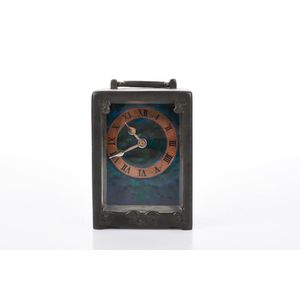
Archibald Knox Liberty Co. Tudric Pewter Enamel Carriage Clock
Archibald Knox for Liberty and Co, Tudric pewter and enamel carriage clock, of rectangular form, with circular dial with Roman numerals on a blue and green enamel face, French movement, impressed model no. '0721' to the underside, height 11.5 cm.…

Antique French Anglaise Grande Sonnerie Bell Striking Carriage Clock
A fine antique French Anglaise grande sonnerie bell striking carriage clock with one piece enamel dial, Roman numerals, original silvered lever platform escapement, push button repeat and striking selection lever to the base, 19th century, 20 cm high

French Brass Carriage Clock with Striking Movement and Roman Numerals
A 19th century French brass cased carriage clock, the quality movement striking on a gong. The white enamel dial with Roman numerals. Height 13.5 cm. Apparently working. With key.

Gilded Antique Carriage Clock with Semi-Clad Maiden Decorations
Antique carriage clock, ornate gilded with high relief decorations with semi clad maiden to corners, white enamel round dial and black Roman numerals
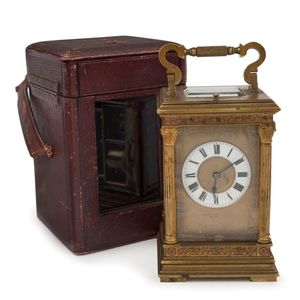
French Anglais Cased Carriage Clock with Eight Day Movement
An antique French Anglais cased carriage clock, eight day time and gong striking movement with push button repeat, manufactured by E. M. & Co., enamel chapter ring with Roman numerals and gilt dial mask, English retailer's name, original Moroccan leather…
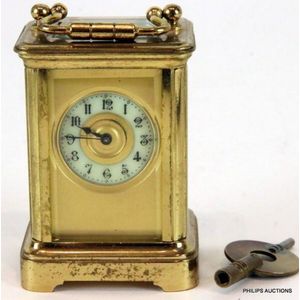
Miniature Brass Carriage Clock with Visible Escapement, circa 1900
A miniature brass carriage clock, circa 1900 with a corniche polished brass case with visible escapement, and an enamel chapter ring with Arabic numerals, swing handle above, complete with double ended key, apparently unmarked, the lever escapement…
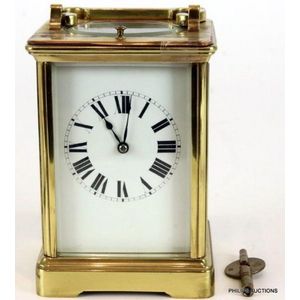
French Brass Striking and Repeating Carriage Clock, Circa 1900
A large French brass striking and repeating carriage clock, circa 1900 the large gilt-brass gong striking repeater with a corniche case with shaped swing handle and white enamelled Roman numeral dial, blued steel hands, with double-ended key, with loose…

Antique Brass Carriage Clock with Alarm by Henri Jacot Paris
A brass carriage clock with alarm by Henri Jacot, Paris, circa 1900 the large bell striking carriage clock with a white enamel dial with Roman numerals and subsidiary alarm dial within a brass corniche case, bevel-glazed on all sides and surmounted with a…

French Brass Carriage Clock by Armand Couaillet, Early 20th Century
A French brass carriage clock, Armand Couaillet, early 20th century the corniche brass case with swing handle and white enamelled Roman numeral dial inscribed with retailer 'Morath Bros Liverpool' and 'Made in France', with visible escapement and glazed…

French brass carriage clock with alarm in leather travel box
French brass carriage clock, travel clock with white enamelled dial and lower alarm, original key and fitted leather travel box

Thwaites & Reed Brass Carriage Clock with Enamel Dial
Thwaites & Reed brass cased carriage clock. Five bevelled glass panels, signed enamel dial with Roman numeral hours. Height 14.5 cm

French Carriage Clock, Circa 1900, Ornate Design, Eight Day Movement
An ornate French carriage clock, circa 1900, a time only clock with eight day movement, well decorated throughout with pierced borders, fluted pilasters and a blue enamel and gilt pierced mask, the silver dial with Roman numerals, without key

French Brass Carriage Clock with Alarm, circa 1900
A French brass carriage clock with alarm, circa 1900 the corniche case with swing handle and white enamelled Roman numeral dial above an Arabic subsidiary alarm dial, with visible escapement and glazed to four sides, the brass twin train bell striking…

Assorted 20th Century Carriage Clocks with Enamel Panels
Three assorted clocks comprising, a French miniature carriage clock timepiece, a vintage French timepiece carriage clock, and a Chinese circular carriage clock with decorative enamel panels, 20th century, the largest 17 cm high

French Gilt Brass Carriage Clock with Engraved Oval Case
A late 19th century French gilt brass carriage clock, oval, shaped handle and engraved case, bevelled glass, white enamel dial with Roman numerals and five minute numerals and subsidiary dial, eight day movement striking on a gong and lever escapement,…

Edwardian gilt brass carriage clock by Mappin & Webb
Edwardian gilt brass and bevelled glass carriage clock with white enamel face by Mappin & Webb

Fattorini & Sons Brass Carriage Clock, Paris, Early 20th Century
A brass carriage clock, Fattorini & Sons, Paris, early 20th century, an eight day alarm clock, the enamel face with Arabic numeral dial and subsidiary dial, single fusee visible escapement, 11.5 cm high, 7.5 cm wide, 6 cm deep

Miniature brass carriage clock with leather case, Sotheby's provenance
A miniature brass carriage clock with leather case, the gilt brass case of oval form with visible escapement, the enamel dial with Arabic numerals, minute markings and a subsidiary seconds dial, 8.5 cm high. Provenance: Sotheby's

Antique French Brass Carriage Clock with Travelling Case
A brass carriage clock and travelling case, early 20th century unmarked but probably French, with a typical corniche style case, white enamel dial with Roman numerals and minute markings, swing handle, visible escapement and bevelled glass glazed to four…

French Brass Miniature Carriage Clock by Henri Jacot, Circa 1900
A French brass miniature carriage clock by Henri Jacot, Henri Jacot, Hj parrot stamp, numbered 10490, circa 1900, the white-enamelled Roman numeral dial, within a brass corniche case with bevelled glass on all sides and surmounted with a swing handle, the…

Bronze Dore Rococo Style Carriage Clock by Aiguilles, 19th Century
19th century bronze Dore rococo style carriage clock, by Aiguilles, with circulr white enamel dial set with Arabic numerals and fine pierced hands, set within a rococo case displaying scrolls, acanthus and flowers, raised on four squat cabriole legs,…

Ingram Bros Brass Carriage Clock: Paris-Melbourne, Circa 1900
A cased brass carriage clock by Ingram Bros, made in Paris, retailed in Melbourne, circa 1900, having an enamel dial with Arabic numerals and a subsidiary dial, with visible escapement, marked Ingram Bros, Paris, Melbourne, with a hard carry case and…

English Brass Carriage Clock, Payne & Sons, Tunbridge Wells
An English brass carriage clock, Payne & Sons, Tunbridge Wells, early 20th century the gilt brass obis-cased carriage clock with beveled glass sides and top, swing handle, Roman and Arabic numeral enamel dial marked 'Payne & Sons, Tunbridge Wells', time…

Brass Corniche Carriage Clock with Carry Case, Early 20th Century
A brass corniche carriage clock with carry case, early 20th century, of typical glazed form with a visible escapement, having an enamel dial with Roman numerals, minute markings and blue steel hands, housed in a red leather and velvet lined case, 11 cm…
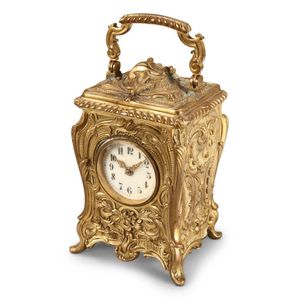
Bronze Dore Rococo Carriage Clock by Aiguilles, 19th Century
19th century bronze dore rococo style carriage clock, by Aiguilles, with circular white enamel dial set with Arabic numerals and fine pierced hands, set within a rococo case displaying scrolls, acanthus and flowers, raised on four squat cabriole legs,…

Exquisite 20th Century French Carriage Clock with Acanthus Scroll
Beautiful early 20th century French carriage clock, set with a circular white enamel dial, with Arabic numerals above a smaller subsidiary seconds dial, surrounded by raised acanthus scroll, with bevelled glass paneled sides, flanked by raised friezes of…

French Brass Carriage Clock with Repeater and Alarm
19th century French brass carriage clock, white enamelled face with black Roman numerals repeater with alarm, height 19 cm
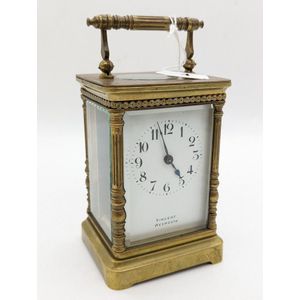
Brass carriage clock with hand painted enamel face
Small carriage clock, a classic brass cased clock with chamfered glass and hand painted enamel face by Vincent of Weymouth. Greek pediment details, one chip to glass, height 16 cm
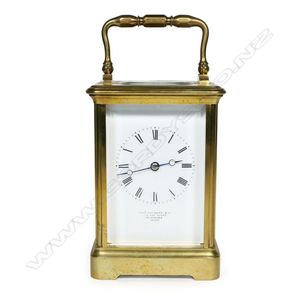
19th Century Brass Carriage Clock by Joseph Soldano
A 19th century brass cased carriage clock by Joseph Soldano, serial number 5190, the white enamel dial with markings of Chas Frodsham and Co., to the Queen, 84 strand and their serial number 18968. In a corniche case with its own key of identical number.…

French Repeater Striking Carriage Clock
A 19th century French repeater striking carriage clock, hour and half hour striking on a bell, in a cannelee case. The back plate detailed in French. The enamel dial with faint retailer/maker's details. Working and with key. Height 17.5 cm to top of…
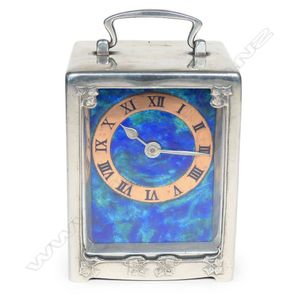
Archibald Knox Tudric Pewter Carriage Clock
A Liberty & Co. Tudric pewter Archibald Knox timepiece carriage clock c1902, the enamel dial with Roman numerals to the copper chapter ring, designed by Archibald Knox, impressed model number 0721 on base. With French movement that runs well however can…

19th Century French Champleve Enamel Strike Alarm Carriage Clock
A highly decorative 19th century French champleve enamel strike alarm 8-day carriage clock, Anglaise style with quality French movement striking on the hour and half hour on a gong. Elaborate multicolour champleve decoration to all four pillars, the top,…

French Brass Carriage Clock with Enamelled Dial
19th century. French brass carriage clock, brass case, bevelled glass with enamelled dial, Roman numerals together with key, in working condition

Enamelled French Carriage Clock with Bevelled Glass
French Edwardian carriage clock, brass cased French unusual horizontal shape with enamelled face, marked Drummond Melbourne, with key and bevelled edge glass

1920 Brass Carriage Clock with Swing Handle
A brass carriage clock, circa 1920, the time only 8-day carriage clock in an obis brass case, with white enamel dial, Roman numerals, beveled glass panels, on platform base, with swing handle, double-ended key, unmarked but probably French height 11 cm

Brass Carriage Clock, Circa 1900
A brass carriage clock, circa 1900, the time only 8-day carriage clock in an obis brass case, with white enamel dial, Roman numerals, beveled glass panels with oval panel on top, on platform base, with swing handle, movement stamped 'A.C.C., L.', probably…
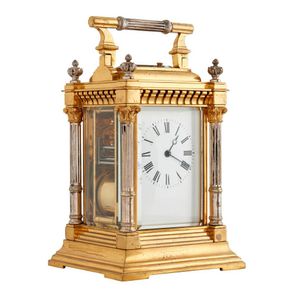
French Petite Sonnerie Carriage Clock with Original Leather Case
A French petite sonnerie carriage clock, last quarter 19th century, the eight day full plate two-train movement with lever platform escapement, striking hours and quarters on two gongs, the enamelled Roman numeral dial in a polished brass and…

Antique French Repeater Carriage Clock with Boer War History
Boer War. Antique French repeater carriage clock in brass case with enamel dial and Roman numerals, housed in original embossed leather case, 19th century. (Movement running), Bears a silver plaque inscribed 'Presented As A Mark Of Their Esteem. By The…
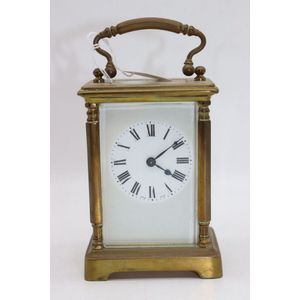
French Brass Carriage Clock with Mechanical Movement
French brass carriage clock, white enamelled face with Roman numerals, dial with brass casing showing mechanical movement with key in working condition
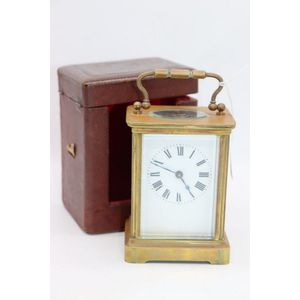
Enamelled French Carriage Clock with Skeleton Sides and Case
French carriage clock, with enamelled face brass cased with skeleton sides, with key and leather travel case

19th Century Brass Carriage Clock with Strike and Repeat Mechanism
A fine, large 19th century brass oval cased carriage clock with strike and repeat mechanism, signed 'Just' and numbered '71189' to the silvered lever escapement platform, the twin barrel movement strikes and repeats on a gong, the white enamel Roman and…

Late Victorian Brass Carriage Clock with Bevelled Glass Panels
A late Victorian brass cased carriage clock, with bevelled glass panel sides, the white enamel dial with Arabic numerals and an alarm dial. Height 15.5 cm. Provenance: Contents of Swanton, Sutton Forest

Victorian Brass Carriage Clock with Bevelled Glass Panels
A Victorian brass cased carriage clock, with bevelled glass panel sides, the white enamel dial with Roman numerals. Height 14.5 cm. Provenance: Contents of Swanton, Sutton Forest

Fine French Carriage Clock by Moise Bolviller, Paris
A fine French carriage clock, Moise Bolviller, Paris, numbered 11, circa 1840, Eight-day repeating movement with alarm and date, bell striking, the lever platform escapement with helical hairspring, the enamelled Roman numeral dial with sweep seconds hand…

French Brass Carriage Clock with Enamel Dial
French carriage clock, brass cased with white enamel dial and black Roman numeral retailed by Emanuel Southampton (original key and leather case)
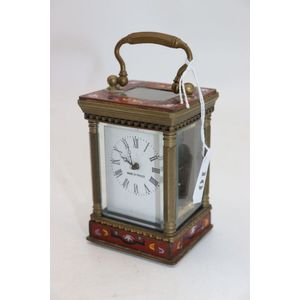
Champleve Enamel French Carriage Clock with Key
French carriage clock, champleve enamel with Roman numerals and original key

Enamelled French Carriage Clock with Exposed Brass Movement
French carriage clock, petite French clock with key, enamelled face with Roman numerals, brass case and exposed movement

Henri Jacot French Repeater Carriage Clock with Leather Case
A quality 19th century French cased repeater carriage clock by Henri Jacot, brass case, enamel dial, gong striking, maker's mark to the back plate, height 14 cm. In fitted original leather case with key, Apparently working.

Matthew Norman Brass Carriage Clock with Alarm
Matthew Norman brass cased carriage clock with alarm white enamel dial, Swiss movement with subsidiary Arabic alarm dial

French Brass Carriage Clock with Enamel Dial and Engraving
French brass carriage clock, L'Epee Sainte, Suzzane France white enamel dial with Roman numerals believed to be gifted to Edmund and Jeanie Barton, first Australian Prime Minister 1901-1903, engraved 'Edmund and Jeanie to Wed is like time Forever', with…

French Corniche Carriage Clock with Full Calendar and Chimes
Very fine quality French Corniche carriage clock manufactured for Le Roy & Fils, Paris. White enamel dial with black Roman numerals to the chapter ring. Full calendar subsidiary dials including day, date, month and alarm with seconds. Push repeat with…

French Carriage Clock with Double Bell Striker
19th century French grand sonnerie carriage clock, in gilt brass, with white enamel dial, double bell striker with underside lever controlling alarm on the hour and quarter, quarter only or silent, a/f (untested, missing minute hand, upper frame with…

French Brass Carriage Clock by Armand Couaillet, c. 1900
A French brass carriage clock, Armand Couaillet (Normandy 1865-1954), circa 1900., the lacquered brass, time only carriage clock in an obis case with a lever escapement, with Roman numeral white enamel dial, beveled glass panels, on platform base with…

Matthew Norman Enamel Carriage Clock
A Matthew Norman gilt metal carriage clock, with enamel face and Roman numerals, blue steeled hands, and subsidiary dial, the movement marked 'Matthew Norman London 1751' and 'Swiss Made', with key. Height 13.5 cm.

Lacquered Brass Carriage Clock with Travelling Case
A French Anglaise cased lacquered brass carriage clock, with four bevelled glass panels, white enamel dial with Roman numerals, striking on a bell with a club tooth right angle lever escapement on a silver platform, with original travelling case and two…

Enamelled French Brass Carriage Clock with Roman Numerals
French brass carriage clock, small proportions with enamelled face and Roman numerals

Brass Carriage Clock by J. Huber Ltd, London
A brass carriage clock. J. Huber Ltd, London, circa 1970 the five-window beveled glass anglaise carriage clock with white enamel Roman numeral dial, the 8-day movement signed by A.C. Gibson, with double-ended key. Height 15 cm, width 8 cm, depth 6 cm

French Brass Carriage Clock with Saqui & Lawrence Retailer's Name
A 19th century French brass cased carriage clock, the cream enamel dial with Arabic numerals and retailer's name 'Saqui & Lawrence London', 7.5 x 6.8 x 10 cm. Apparently working with key.

Richard & Co. French Carriage Clock, Gilt Brass, Enamel Dial
French repeating carriage clock, by Richard & Co. Paris, with gilt brass frame with glazed panels, enamel dial with Roman numerals, height 17 cm
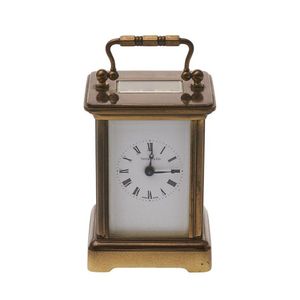
Tiffany & Co Brass Carriage Clock
A Brass Carriage Clock, Tiffany and Co, Dimensions 57 x 80 x 50 mm. Brass case with glass pannels, mechanical key wound movement 11 jewels, white enamel dial with Roman hour markers and breguet style hands, dial singed Tiffany & Co, Swiss made. With brass…

French Gilt Bronze Carriage Clock with Timber Case
19th century French carriage clock, in gilt bronze, 8 day movement, with horizontally opposed rectangular case with masked white porcelain dial and enamel Arabic hour markers, with escapement viewing window set below an elongated loop handle, with rear…

Large Antique Brass Carriage Clock with Striking Movement
Antique large brass cased carriage clock oval shaped brass and glass case, Roman numerals to enamel dial, with striking movement, 2 keys available, needs service, height 18 cm, handle extended, in original fitted leather case. Glass to back door has chips.
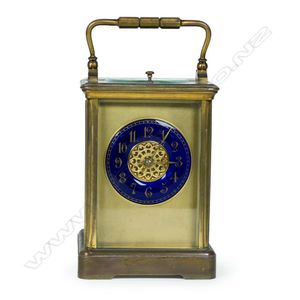
Large French Brass Carriage Clock, 19th Century
A 19th century French brass repeating carriage clock, of large size, with blue convex enamelled chapter ring with Arabic numerals, the quality movement striking on a gong. Height 13.2 cm to top of case. With key. Apparently working.

French Enamelled Brass Carriage Clock with Bevelled Glass Sides
A French brass carriage clock, the enamelled dial with Roman numerals, and bevelled glass sides. Dimensions 13 x 9 x 8 cm.

Vintage Mignon Carriage Clock in Red Leather Case
A vintage miniature carriage clock, white enamel dial with blue Arabic numerals and 'Mignon' to the centre, in red Morocco leather case, not working. 4.5 x 6.5 cm.

Rare French Enamelled Double Carriage Clock with Barometer and Compass
Rare French double carriage clock, with beautifully enamelled duel faces on white enamelled dials, one clock and opposite barometer with upper compass

Antique French Carriage Clock by Henri Acier
An antique French carriage clock, probably by Henri Acier, late 19th century, of typical form in a polished brass and glazed case, the black on white enamelled Roman numeral dial with minutes ring above Arabic numeral alarm dial, the underside of the case…

Henri Jacot French Architectural Carriage Clock, Circa 1900
A French architectural carriage clock, by Henri Jacot, circa 1900, the French strike, on gong, with lever platform, with a gilded bronze case, incorporating Corinthian columns, serpentine top and base, encasing a circular enamel dial with Arabic numerals,…

19th Century French Striking Carriage Clock with Enamel Panels
19th century French striking carriage clock, by Gay Lamille with Surety roller patent and Hardy Bros retail mark, with circular gilt dial set with black Roman numerals, set within a facetted case with an enamel panel to either side depicting Henry VIII…

French Silver Guilloche Carriage Clock & Case
Delightful French miniature silver and guilloche carriage clock and case, early 20th century, marked Jtc (Geneva clock Company) to base, case #4703, #12565 to movement, of rectangular form set with loop handle, the white enamel dial set with Arabic…
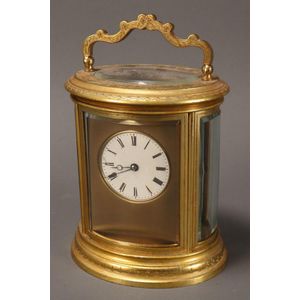
French Gilt Brass Carriage Clock with Bell Striker
French gilt brass oval carriage clock, with bell striker, the shaped handle surmounting an oval shaped case with bevelled glass windows, the circular white enamel dial set with Roman numerals within a gilt mount, with incised acanthus leaf and drapery…

Brass Carriage Clock with Visible Escapement
Late Victorian brass cased carriage clock with swing handle, visible escapement, the white enamel with Roman numerals

Brass Carriage Clock with Visible Escapement and Swing Handle
Brass cased carriage clock with swing handle, visible escapement, white enamel dial with Roman numerals, 11 cm high

Brass Carriage Clock with Visible Escapement and Grohe Retailer
Brass cased carriage clock with swing handle, visible escapement, the white enamel dial with retailers name of Grohe

Victorian Brass Carriage Clock with Visible Escapement
Small Victorian brass cased carriage clock with swing handle, visible escapement, engraved decoration, white enamel dial (af) with engine turned surround and morocco case

Gilt-Brass Carriage Clock with Striking and Enamel Dial
A gilt-brass carriage clock with striking on gong, French, with an enamel dial, Roman numerals, the case inset with bevelled glass, 14.5 cm high

French Enamel Carriage Clock with Floral Embossing
A round carriage clock, French, on three hoof feet, the enamel face with a Roman numeral dial, decorative floral embossing to the case, 17 cm high

Ornate French Gong Striking Carriage Clock
A large ornate gilt-brass gong striking carriage clock, French, with engraved gilt surrounding an enamel dial, Roman numerals, the gilt case with corner pillars inset with bevelled glass and a shaped handle, 14.5 cm high
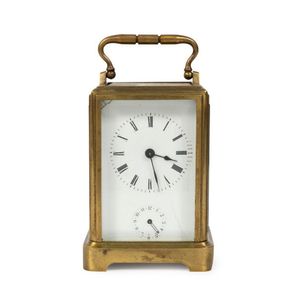
Gilt-Brass Bell Strike Carriage Clock with Alarm
A gilt-brass bell strike movement carriage clock with alarm, French, with alarm, an enamel dial wiith Roman numerals, the one piece rectangular case inset with bevelled glass and shaped handle, 12 cm high

French Brass Carriage Clock by L'Epee in Leather Case
A French brass carriage clock in case, by L'Epee, the enamelled Roman numeral dial within a polished brass case of oval outline with a swing handle, in a leather case.

French Brass Carriage Clock with Striking Movement
A French brass striking carriage clock, stamped R & Co, Paris, height 18 cm fully glazed corniche case surmounted by a swing handle, with white enamel dial and black Roman numerals, cylinder escapement twin barrel movement, striking on a gong, half and…

West German Brass Carriage Clock by Aug. Schatz & Sons
A West German brass carriage clock, by Aug. Schatz and Sons, enamel dial, glass panels. Key available. Height 16 cm.

Comitti London Brass Carriage Clock with Enamel Dial
An English brass carriage clock, by Comitti London, enamel dial, and glass panels. Key available. Height 15 cm.

French Brass Carriage Clock with Enamel Dial
A 19th century eight day French carriage clock, with brass case, enamel dial, bevelled glass and key. Height 12 cm.

Antique Brass Carriage Clock with Enamel Dial
A 19th century carriage clock, brass and bevelled glass case, the white enamel dial marked 'Goldsmith and Silversmith Company, 112 Regent Street, London', striking on a gong, with key. Height 18 cm

French Brass Carriage Clock with Enamel Dial
Late 19th century French carriage clock, in a brass corniche case set with a white enamel dial and Roman numerals, with escapement viewing window to top, marked France to rear, height 11 cm

Golay Fils & Stahl Carriage Clock with Leather Case
A 19th century repeating carriage clock, eight-day gong striking movement, the white enamel face with Roman numerals, marked Golay Fils & Stahl, Geneve, with original Morocco leather case, with key, in good working condition and has recently be serviced…

Brass Carriage Clock with Fluted Columns in Travel Case
A brass cased carriage clock, with wrythen fluted spiral corner columns and handle, cream enamel face with blue painted Arabic numerals, in travelling case, height 14.5 cm

Brass Carriage Clock with Leather Case
A 19th century brass carriage clock, of traditional design with white enamelled face and black Roman numerals, in original Morocco leather travelling case.

Brass Carriage Clock with 8-Day Repeater
Mathew Norman brass carriage clock - 8 day repeater. White enamel dial with Roman numerals, with key and leather case. Height 16.5 cm, case)

French Brass Striking Carriage Clock with Enamel Dial
A good 19th century French large brass cased striking carriage clock, the white enamel dial with Roman numerals and New Zealand retailers name Hislop & Co. The quality movement striking on a gong. Apparently working. Height 14.5 cm to top of case.…

French Brass Carriage Clock, 19th Century
A 19th century brass cased French carriage clock, the white enamel dial with Roman numerals and subsidiary alarm dial, striking on a bell. Presentation engraved 'The Rev'd. H.J. Could...1878'. Height 11 cm to top of case.

French Kangaroo Brass Carriage Clock with Case
A French miniature brass carriage clock, the front engraved with a kangaroo on a boomerang and 'W.A 1931'. The white Roman numeral enamel dial made in France. Together with a leather carrying case, height 8.5 cm

French 19th Century Gilt Carriage Clock
Beautiful 19th century French carriage clock and case, set with a white enamel dial with Roman numerals, surrounded by an ornate gilt surround displaying scrolled acanthus, within a brass case, with half hour and repeating striker, height 12.5 cm (handle…

French Brass Carriage Clock, c.1900
A French brass carriage clock, c.1900, white enamel dial with Roman numerals. Height 14 cm

 Loading more...
Loading more...